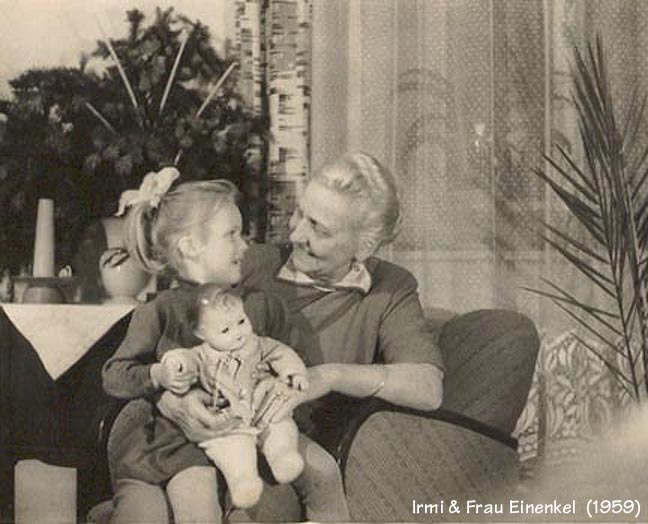 |
| |
| sharing
a little girl talk with the lady next door |
| Greiz
(Thüringen), Germany (1959) |
| |
| Left:
Irmhild Rosemarie (Scharna) Karpinski (b. 1956) |
| Right:
Brunhilde Einenkel (1893-1984) |
| |
|
As
a young woman, Brunhilde
Einenkel lost her fiancé on a World War I battlefield. |
|
|
Due
to her grief, and a shortage of men after the war, she never
married, remaining |
|
|
forever
"Fräulein Einenkel." Early in life, she trained as a
photographer and quickly |
|
|
established
a good
reputation in that line of work; however, during a
visit to Sweden |
|
|
in
1921, a doll exhibition so completely fascinated her that, upon
returning home, she |
|
|
began
creating her own dolls as a hobby. In less than a year, the new hobby
evolved |
|
|
into
a full-time enterprise, as Brunhilde Einenkel's uniquely expressive dolls
became |
|
|
As
a young woman, Brunhilde
Einenkel lost her fiancé on a World War I battlefield. |
|
|
sought-after
items at the main market place
in nearby Leipzig. They remained
in such |
|
|
demand
that Brunhilde continued producing them for the next sixty years (from 1922 |
|
|
through
1982). Long after her death, her artistry is still highly regarded.
A museum |
|
|
in
the German state of Thüringen has one entire display devoted to
Einenkel Dolls. |
|
| |
|
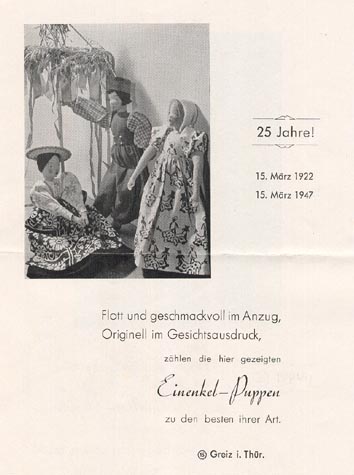
|
| |
|
The
flyer above, saved by Irmi's mother, Rosemarie, announced the 25-Year Jubilee |
|
|
of
Einenkel Dolls
in March 1947. It reads: "Stylish and tasteful in
dress, original in |
|
|
facial expression,
the Einenkel Dolls shown here number
among the best of her type." |
|
| |
|
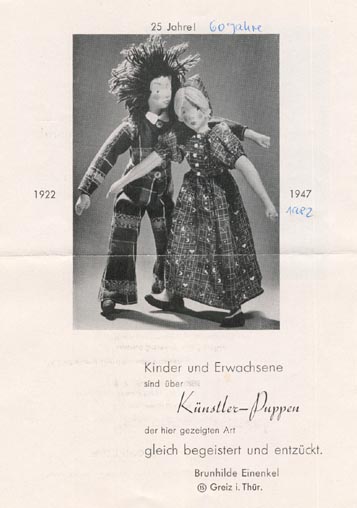
|
| |
|
Above
is the reverse side of the 25-Year Jubilee flyer, which reads: "Children
and |
|
|
adults are
enthusiastic and captivated by the type of artisan dolls represented
here." |
|
|
|
|
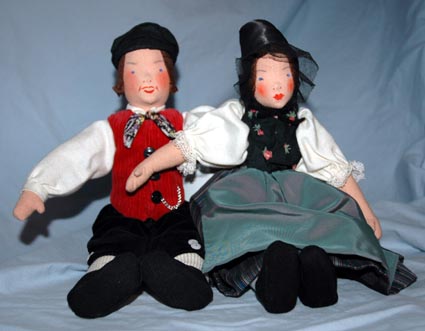
|
| |
|
In
the late 1950's, Brunhilde Einenkel gave eight of her dolls to the
Scharna family |
|
|
who
lived next door to her in the former east German city of Greiz.
The Scharna's |
|
|
had
four small daughters, and each girl received a matching set of dolls.
The pair |
|
|
above,
reverently preserved by my wife, Irmi, are proudly displayed
in our home. |
|
| |
|
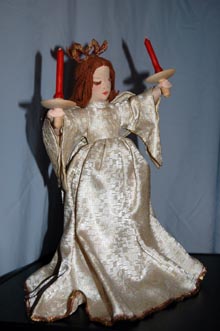
|
| |
|
In
1959, little more than a year before the Scharna family fled to West
Germany, |
|
|
Brunhilde
Einenkel presented this
Christmas tree angel (above) to Irmi's mother, |
|
|
Rosemarie
Scharna, in appreciation for the many times Rosemarie had watered the |
|
|
plants in
Brunhilde's apartment while she was away. Later, during more than thirty |
|
|
Christmas
seasons in the west, this angel sat atop the annual Scharna family tree, |
|
|
first
and foremost as a symbol of their
roots in
the east, but also as a reminder of |
|
|
an
enduring friendship with a compassionate and talented
lady. Today, this
angel, |
|
|
in
Irmi's care now, continues to play a prominent role in our
holiday celebrations. |
|
|
|


|